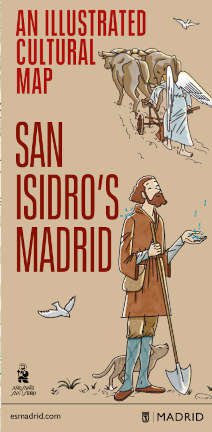An Ilustrated Cultural Map: San Isidro's Madrid (PDF)
 There are few cities that identify as strongly with their patron saints as Madrid. The protective, benevolent halo of San Isidro (Isidore the Labourer) has shone in every era. While the city has undergone profound changes, they haven’t affected the way his virtuous life and miracles are commemorated or the continued existence of places linked to the most popular traditions associated with him, which have adapted with the times.
There are few cities that identify as strongly with their patron saints as Madrid. The protective, benevolent halo of San Isidro (Isidore the Labourer) has shone in every era. While the city has undergone profound changes, they haven’t affected the way his virtuous life and miracles are commemorated or the continued existence of places linked to the most popular traditions associated with him, which have adapted with the times.
What we know about the life and death of the humble farm labourer Isidore, patron saint of the city of Madrid and protector of agriculture, is rooted more in popular legend and tradition than documentary sources. The scant written information that exists on him comes from a manuscript known as the Codex of John the Deacon. It mentions very little about the era in which the saint lived, although most scholars place him during the 11th and 12th centuries, roughly between 1082 and 1172. Although the memory of his exemplary life was kept alive by the people, his veneration as a saint didn’t begin until the 13th century, when his incorrupt body appeared in the Cemetery of San Andrés.
The solemn canonisation of Saint Isidore, which took place on 12 March 1622 alongside that of St Teresa of Ávila, St Ignatius of Loyola, St Francis Xavier and St Philip Neri, was one of the most significant events to occur in Madrid during the reign of Philip IV. Important festivities were held, featuring the participation of all of the court’s great writers and intellectuals, particularly Lope de Vega, who composed several plays for the occasion including his famous work Isidore: Spanish Poem (Isidoro. Poema castellano), which depicts the saint’s life in Madrid at the beginning of the Christian conquest of the city. Over time, Isidore’s legacy continued to grow, until in 1960 Pope John XXIII named him patron saint of all labourers, confirming his importance and the global reach of the reverence he has inspired.
Isidore the Labourer and his wife, Maria Torribia (also known as Santa María de la Cabeza), reflect the city’s open, festive spirit. They have always inspired affection and respect from Madrileños and all the “Isidros” who every year visit the places linked to his life. Particularly popular was the hermitage where, according to tradition, the saint made water spout from the earth to quench the thirst of his employer, Iván de Vargas. In recent years, San Isidro Park, located in what was once a meadow next to the hermitage, continues to receive crowds of Madrileños on 15 May, the saint’s feast day. The festivities will be extra special this year, as it marks the 4th centenary of his canonisation.
Eduardo Salas Vázquez (b. 1959; Madrid) Director of the Museum of San Isidro: The Origins of Madrid

